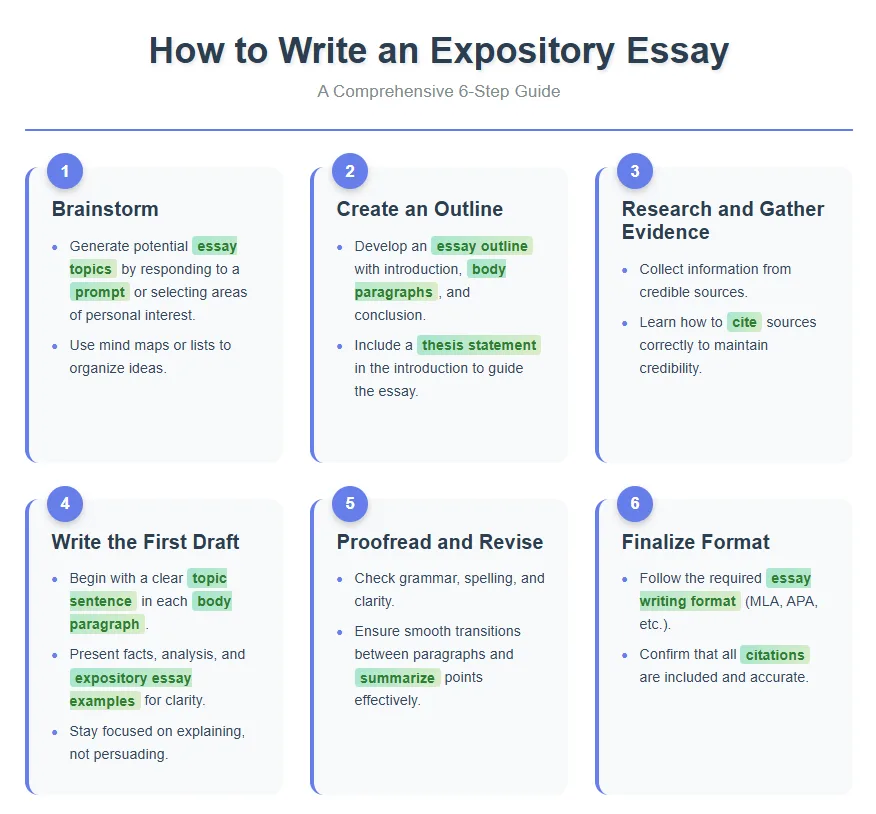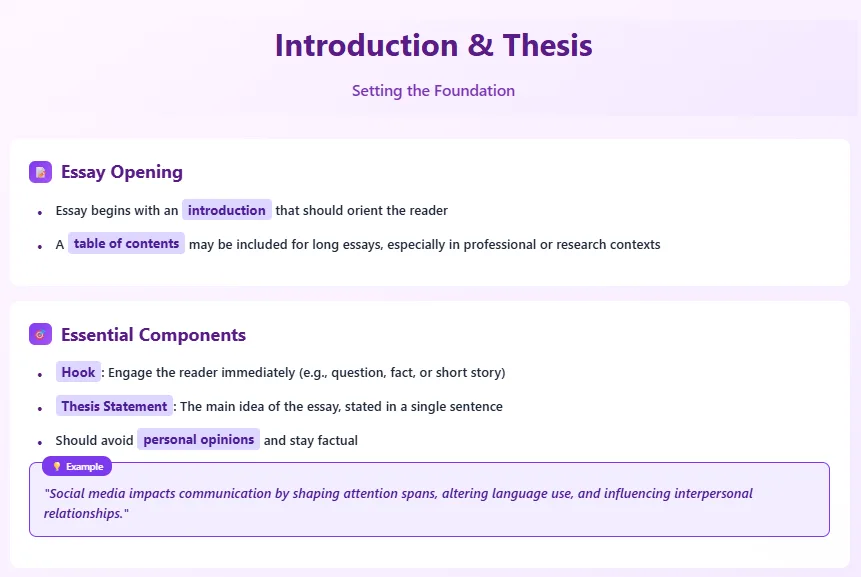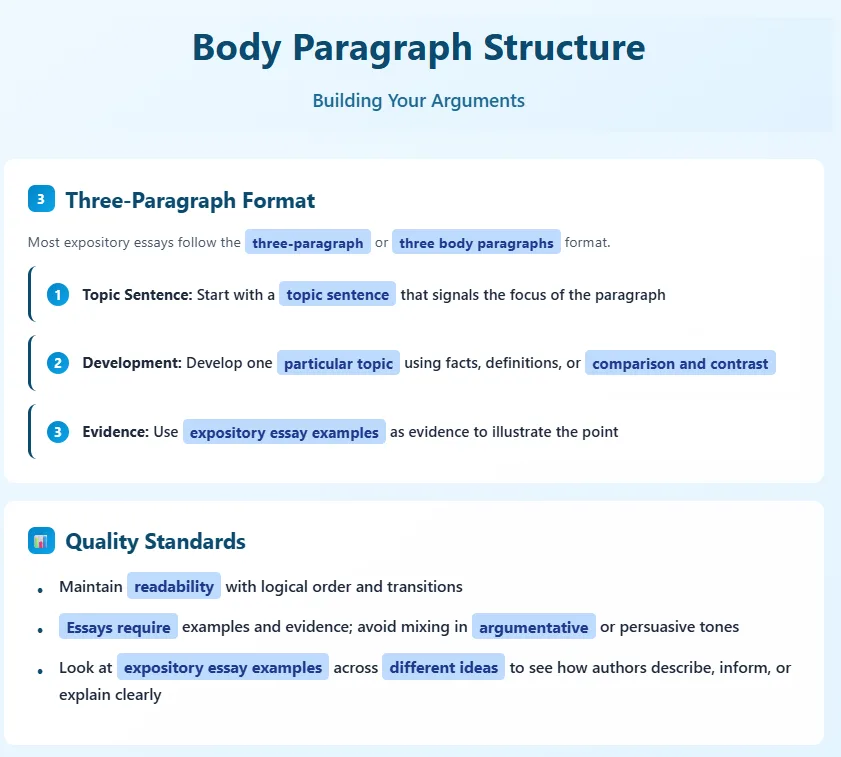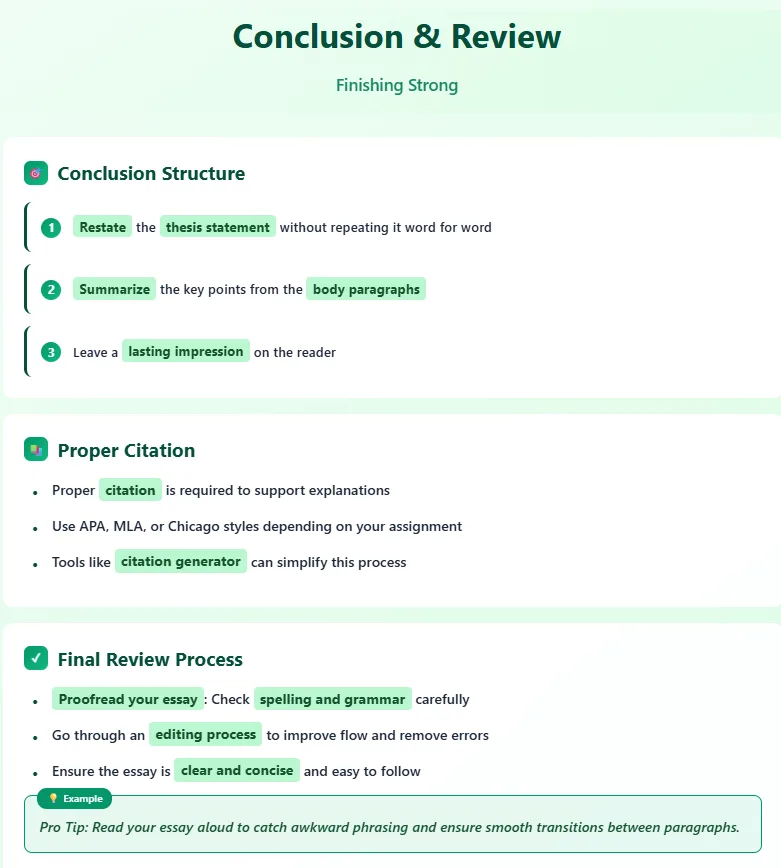What Is an Expository Essay?
- Definition
- An expository essay is a form of expository writing that aims to explain, clarify, or describe a subject in a concise and logical manner.
- Unlike a persuasive essay, it does not argue for or against an opinion but instead presents facts and explanations.
- Purpose
- Helps readers understand a topic thoroughly.
- Provides structured evidence, analysis, and examples.
- Core Features
- Clear thesis statement that summarizes the central idea.
- Logical essay outline with introduction, body paragraphs, and conclusion.
- Use of reliable citation and proper format to support claims.
- Examples
- Many expository essay examples focus on topics such as history, science, or social issues.
- Each essay example demonstrates how to summarize information, organize it with a strong topic sentence, and conclude effectively.
How to Write an Expository Essay: A 6 Step by Step Guide
Step 1: Brainstorm
- Purpose: The first step in learning how to write an expository essay is generating ideas that respond to the prompt or chosen subject.
- Process:
- Make a list of potential essay topics that are factual, not opinion-based.
- Use brainstorming tools such as mind maps, free-writing, or digital note apps.
- Narrow broad ideas into manageable subjects that can be fully explained in the given word count.
- Example: Instead of “climate change,” refine to “effects of climate change on coastal cities.”
- Tip: Review expository essay examples online or in textbooks to see how authors transform general prompts into specific, focused essays.
- To build your own explanatory essay, start by reviewing engaging expository essay topics that pair well with the examples provided here.
Step 2: Create an Outline
- Purpose: An essay outline provides a roadmap for your writing and ensures logical flow.
- Structure:
- Introduction
- Hook to capture interest.
- Clear thesis statement summarizing the main explanation.
- Body Paragraphs
- Each begins with a topic sentence.
- Present one key idea supported by facts, examples, and analysis.
- Conclusion
- Summarize main points without adding new arguments.
- Conclude by reinforcing how the explanation addressed the prompt.
- Introduction
- Example: Many expository essay examples demonstrate outlines before drafting to keep the essay concise and well-organized.

Step 3: Research and Gather Evidence
- Purpose: Strong expository writing depends on credible information.
- Process:
- Use academic journals, books, reliable websites, and databases.
- Take detailed notes and group them under the headings of your outline.
- Track all sources so you can cite them correctly.
- Citation and Format:
- Use MLA, APA, or Chicago depending on your assignment requirements.
- Every fact or quotation must have a citation to avoid plagiarism.
- Tip: When studying expository essay examples, pay attention to how writers integrate research into their body paragraphs to support explanations.
Step 4: Write the First Draft
- Purpose: This stage turns your ideas and outline into a full essay.
- Process:
- Start with the introduction: hook + thesis statement.
- Develop body paragraphs:
- Each begins with a topic sentence.
- Follow with facts, analysis, and at least one essay example or real-life case.
- End with a mini-summary to transition smoothly.
- Avoid opinionated or emotional language—reserve that for a persuasive essay.
- Example: A cause and effect essay draft might explain how excessive screen time (cause) influences sleep patterns (effect). Reviewing expository essay examples will help you model clear, factual explanation.
Step 5: Proofread and Revise
- Purpose: Refining ensures that your writing is polished, accurate, and professional.
- Steps:
- Proofread for grammar, punctuation, and spelling errors.
- Check sentence flow and readability—make sure your style is concise.
- Verify transitions between paragraphs to maintain logical progression.
- Ensure your essay directly answers the prompt and matches the outline.
- Ask: Does every body paragraph connect to the thesis statement?
- Tip: Compare your draft with published expository essay examples to see whether your explanation is as clear and organized.
Step 6: Finalize Format
- Purpose: Proper format and presentation show professionalism in essay writing.
- Checklist:
- Apply the required citation style (APA, MLA, Chicago).
- Confirm all citations are accurate and sources are properly listed in a bibliography.
- Ensure consistent margins, font, and spacing.
- Title your essay appropriately based on the essay type (for example, Comparative Essay on Renewable and Non-Renewable Energy).
- Tip: Before submission, summarize your process to ensure no steps were missed: brainstorm, outline, research, draft, revise, finalize.
- Want to connect examples with bigger concepts? Our overview of thematic essays explains how explanations link to central ideas.
Essay Services
Expert support for every stage of essay.
- Assistance with topic selection
- Step-by-step essay writing help
- Editing, proofreading, and formatting help
Free Consultation
Talk to our essay experts before you begin.
- One-on-one discussion of your essay
- Guidance on essay structure and citations
- Tailored advice to your course guidelines
Expository Essay Examples
- Overview
- There are several essay types under the expository category.
- Each provides different approaches to presenting information.
- Exploring expository essay examples of each essay type helps learners understand structure and content.
Cause-and-Effect Essay
- Definition
- Explains relationships between causes and consequences.
- A classic cause and effect structure often answers “why” and “what happened.”
- Structure
- Introduction with thesis statement.
- Body paragraphs linking specific causes to their effects.
- Logical flow using transitional phrases like “as a result” or “therefore.”
- Example
- An essay example might analyze how social media affects mental health.
- Using expository essay examples in this style teaches students how to logically trace outcomes.
Cause-and-Effect Essay Example
The Impact of Social Media on Teen Mental Health
Social media has become a central part of teenage life, shaping the way young people communicate, learn, and view themselves. While it offers opportunities for connection and creativity, its influence on mental health has raised serious concerns. The relationship between social media use and teen well-being is largely explained through a cause-and-effect framework. Constant connectivity, comparisons, and exposure to digital content have caused an increase in anxiety, depression, and low self-esteem among teenagers.
The first cause of social media’s impact is the expectation of constant connectivity. Teens spend hours each day scrolling through feeds, posting updates, and responding to messages. This digital immersion creates pressure to remain always available, leading to fatigue and stress. It often reduces the time teens spend on healthy activities such as exercise, family interaction, and in-person friendships, which are vital for mental balance (Twenge 78).
One effect of this constant connectivity is heightened anxiety. Social media fosters an environment of comparison, where teenagers measure their self-worth by likes, comments, or followers. If their posts do not receive the expected attention, they may feel rejected or inferior. Research has consistently linked high social media use with social anxiety, as teens tie their confidence to online validation (APA 2020).
Another effect is depression. Although designed to connect people, social media often makes teens feel more isolated. Online exchanges can feel shallow, and the absence of meaningful in-person interactions increases feelings of loneliness. Additionally, cyberbullying, a frequent occurrence on these platforms, exacerbates sadness and hopelessness. Studies show that teens spending more than three hours a day online are significantly more likely to experience depressive symptoms (Keles et al. 131).
A further effect is poor self-esteem. Social media platforms showcase carefully curated images of beauty, wealth, and success. Teenagers, still forming their identities, internalize these unrealistic standards. They may feel dissatisfied with their own lives, leading to body image issues and low self-confidence (Perloff 364).
In conclusion, the cause-and-effect relationship between social media and teen mental health highlights concerning outcomes. Constant connectivity causes teens to experience anxiety, depression, and poor self-esteem. While social media has benefits, such as keeping friends connected, its negative effects cannot be ignored. Parents, educators, and policymakers should encourage balanced use, promote offline activities, and raise awareness about comparison culture. By addressing the causes, society can reduce the harmful effects and help teens build healthier online habits.
Works Cited
- American Psychological Association. Social Media and Teens’ Mental Health. APA, 2020.
- Keles, Betul, et al. “A Systematic Review: The Influence of Social Media on Depression, Anxiety, and Psychological Distress in Adolescents.” International Journal of Adolescence and Youth, vol. 25, no. 1, 2020, pp. 79–93.
- Perloff, Richard M. “Social Media Effects on Young Women’s Body Image Concerns: Theoretical Perspectives and an Agenda for Research.” Sex Roles, vol. 71, 2014, pp. 363–377.
- Twenge, Jean M. iGen: Why Today’s Super-Connected Kids Are Growing Up Less Rebellious, More Tolerant, Less Happy—and Completely Unprepared for Adulthood. Atria Books, 2017.
- If you’d like to compare explanatory writing with persuasive arguments, check out our detailed argumentative essay examples.
Problem and Solution Essay
- Definition
- Identifies a problem and proposes solutions.
- Common in academic essay writing to demonstrate critical thinking.
- Structure
- Introduction outlines the problem.
- Body paragraphs describe possible solutions.
- Solutions are explained with evidence, not opinion, which distinguishes it from a persuasive essay.
- Example
- An essay example could discuss climate change and solutions like renewable energy.
- Expository essay examples here show how to write expository responses to global issues.
Problem and Solution Essay Example
Reducing Plastic Pollution in Oceans
Plastic pollution has become one of the most urgent environmental challenges of our time. Millions of tons of plastic waste enter the oceans every year, threatening marine life, ecosystems, and even human health. To address this problem, it is important to understand its sources and explore realistic solutions. Reducing single-use plastics, improving recycling infrastructure, and promoting international cooperation are essential steps in solving the crisis of plastic pollution.
The first major problem is the overuse of single-use plastics such as bottles, bags, and packaging. These items are used briefly but last for hundreds of years, eventually breaking into microplastics that pollute waterways and oceans. Marine animals often mistake these plastics for food, leading to injury or death. Humans are not spared either, since microplastics enter the food chain and can be consumed through seafood, posing health risks (United Nations Environment Programme [UNEP], 2021).
Another problem is the lack of effective recycling systems. In many countries, recycling infrastructure is limited or poorly managed, which means that most plastic ends up in landfills, rivers, or oceans. Even where recycling programs exist, issues such as contamination of materials and low demand for recycled products reduce their effectiveness (Geyer et al., 2017). Without improvement, this inefficiency will continue to add millions of tons of plastic waste to the oceans.
One solution to plastic pollution is reducing the production and use of single-use plastics. Governments can introduce bans or taxes on items like plastic bags and straws to discourage overconsumption. Consumers also play a role by switching to reusable alternatives such as cloth bags, metal bottles, and eco-friendly packaging. Countries that have adopted plastic bag bans have already seen significant reductions in waste, proving this solution is practical and impactful (Xanthos & Walker, 2017).
Another solution involves improving recycling systems and encouraging innovation. Investments in advanced recycling technology, such as chemical recycling, allow plastics to be converted back into raw materials. At the same time, businesses can innovate by designing biodegradable materials that naturally decompose. These measures, supported by strong government incentives, can reduce reliance on traditional plastics (Jambeck et al., 2015).
Lastly, international cooperation is critical in addressing ocean plastic pollution. Since plastic waste travels across borders through ocean currents, global agreements are necessary. Campaigns such as the United Nations’ Clean Seas initiative promote collaboration between nations, industries, and citizens. By working together, countries can share technology, fund research, and enforce regulations that limit plastic pollution worldwide (UNEP, 2021).
In conclusion, ocean plastic pollution is a global problem with devastating consequences for marine life and human health. However, solutions exist. Reducing single-use plastics, improving recycling systems, and fostering international cooperation can make a meaningful difference. While the challenge is large, collective effort and innovation can ensure cleaner oceans and a healthier planet for future generations.
References
- Geyer, R., Jambeck, J. R., & Law, K. L. (2017). Production, use, and fate of all plastics ever made. Science Advances, 3(7), e1700782. https://doi.org/10.1126/sciadv.1700782
- Jambeck, J. R., Geyer, R., Wilcox, C., Siegler, T. R., Perryman, M., Andrady, A., … & Law, K. L. (2015). Plastic waste inputs from land into the ocean. Science, 347(6223), 768–771. https://doi.org/10.1126/science.1260352
- United Nations Environment Programme. (2021). From pollution to solution: A global assessment of marine litter and plastic pollution. Nairobi: UNEP.
- Xanthos, D., & Walker, T. R. (2017). International policies to reduce plastic marine pollution from single-use plastics (plastic bags and microbeads): A review. Marine Pollution Bulletin, 118(1–2), 17–26. https://doi.org/10.1016/j.marpolbul.2017.02.048
- To add vivid detail to clear explanations, see how it’s done in our descriptive essay examples.
Comparative Essay
- Definition
- Focuses on similarities and differences between two or more subjects.
- Often used in literature, history, or culture classes.
- Structure
- Point-by-point or block method.
- Each paragraph begins with a topic sentence highlighting a similarity or difference.
- Example
- A comparative essay may explore democracy vs. monarchy.
- Expository essay examples highlight how to balance comparison and explanation.
Comparative Essay Example
Online Education vs. Traditional Classroom Learning
Education has always been a key driver of progress, but the methods of learning have evolved significantly. Today, students have the option of attending traditional classrooms or participating in online education. Both approaches aim to deliver knowledge, yet they differ in accessibility, interaction, flexibility, and overall effectiveness. Comparing these two models highlights the strengths and weaknesses of each and suggests how they might complement one another.
Online education offers unmatched accessibility. With just an internet connection, students from remote or underserved areas can attend courses offered worldwide. It eliminates barriers of distance, making education more inclusive. In contrast, traditional classroom learning requires physical presence, which limits access for those living far from institutions. However, classrooms often provide resources such as laboratories and libraries, which remain difficult to replicate online (Allen & Seaman, 2017).
Interaction is another key area of difference. Traditional classrooms encourage face-to-face communication with teachers and peers, allowing for spontaneous discussions and collaborative group work. These interactions foster social bonds and teamwork skills. Online learning, on the other hand, relies on digital platforms such as discussion boards or video calls. While these tools offer engagement, they can feel less personal and may limit the depth of relationships formed (Hrastinski, 2008).
Flexibility is where online learning stands out. Students can learn at their own pace, review recorded lectures, and schedule study time around other responsibilities. This makes it ideal for working adults or those with family obligations. Traditional classrooms, however, operate on fixed schedules that promote discipline and routine. For some students, this structure is beneficial, while for others it may be restrictive (Means et al., 2013).
When evaluating effectiveness, both methods show strengths. Traditional classrooms promote discipline and provide immediate feedback through direct interactions with instructors. Online education enhances learning with multimedia tools, personalized modules, and adaptive technologies. Research suggests that blended learning models, which combine face-to-face teaching with online resources, often provide the most effective results by drawing on the advantages of both systems (Bernard et al., 2014).
In conclusion, both online education and traditional classroom learning have unique advantages and limitations. Online education is highly accessible and flexible, while traditional classrooms excel in interaction and structured learning. Rather than viewing them as competing systems, a hybrid model that combines their strengths may best serve students. Education in the modern world does not need to be one-size-fits-all; instead, it should adapt to the diverse needs of learners.
Reference List
- Allen, I.E. & Seaman, J. (2017) Digital learning compass: Distance education enrollment report 2017. Babson Survey Research Group.
- Bernard, R.M., Borokhovski, E., Schmid, R.F., Tamim, R.M. & Abrami, P.C. (2014) A meta-analysis of blended learning and technology use in higher education: From the general to the applied. Journal of Computing in Higher Education, 26(1), pp. 87–122.
- Hrastinski, S. (2008) Asynchronous and synchronous e-learning. Educause Quarterly, 31(4), pp. 51–55.
- Means, B., Toyama, Y., Murphy, R., Bakia, M. & Jones, K. (2013) Evaluation of evidence-based practices in online learning: A meta-analysis and review of online learning studies. Washington, DC: U.S. Department of Education.
- If you’d like to balance facts with storytelling, explore our narrative essay examples.
How to Format an Expository Essay
- Formatting is an essential part of the writing process in academic writing.
- An expository essay is a genre of essay writing where the purpose is to explain, describe something, or inform about a particular topic or particular phenomenon in a clear and concise way.
- Expository essays are usually written in the five-paragraph structure: introduction, three body paragraphs, and a conclusion.
- Reviewing expository essay examples provides guidance on how to orient your ideas, maintain readability, and structure content effectively across different topics.
Introduction and Thesis Statement
- Essay begins with an introduction that should orient the reader.
- A table of contents may be included for long essays, especially in professional or research contexts.
- Essential components:
- Hook: Engage the reader immediately (e.g., question, fact, or short story).
- Thesis Statement: The main idea of the essay, stated in a single sentence.
- Should avoid personal opinions and stay factual.
- Example: “Social media impacts communication by shaping attention spans, altering language use, and influencing interpersonal relationships.”
- Reviewing expository essay examples will show how the introduction sets the tone.
- Whether it is a short expository essay, informative essay, or descriptive essay, the introduction must orient and clearly outline what the essay serves to achieve.

Body Paragraph Structure
- Most expository essays follow the three-paragraph or three body paragraphs format.
- Each paragraph should:
- Start with a topic sentence that signals the focus.
- Develop one particular topic using facts, definitions, or comparison and contrast.
- Use expository essay examples as evidence to illustrate the point.
- Maintain readability with logical order and transitions.
- Essays require examples and evidence; avoid mixing in argumentative or persuasive tones.
- Tools such as Scribbr or a citation generator (even free AI tools) can help cite sources properly and ensure the essay does not reproduce information incorrectly.
- Look at expository essay examples across different ideas to see how authors describe, inform, or explain clearly.

Conclusion, Citation, and Proofreading
- Conclusion of an expository essay:
- Restate the thesis statement without repeating it word for word.
- Summarize the key points from the body paragraphs.
- Leave a lasting impression on the reader.
- Proper citation is required to support explanations:
- Use APA, MLA, or Chicago styles depending on your assignment.
- Tools like citation generator can simplify this.
- Proofread your essay:
- Check spelling and grammar carefully.
- Go through an editing process to improve flow and remove errors.
- Ensure the essay is clear and concise and easy to follow.
- Reviewing expository essay examples helps writers understand how to conclude effectively and create polished essays that inform the reader on different topics.
- Always consider frequently asked questions about structure and topic ideas before you start writing to ensure success.

- Looking to move from explanations into debates? Review our list of argumentative essay topics for persuasive inspiration.
- Explanatory and descriptive styles often overlap — explore our range of descriptive essay topics for more ideas.
- Interested in blending explanation with storytelling? Browse our list of narrative essay topics.
FAQs About Expository Essays
-
What is an expository essay?
An expository essay is a type of academic writing that explains or describes a particular topic using facts, evidence, and examples. It avoids personal opinions and instead presents information in a clear and logical way to help the reader understand the subject.
-
What is an example of expository writing?
An example of expository writing could be a school essay that explains the effects of climate change, a textbook chapter that describes photosynthesis, or an article that outlines how recycling works. Each one presents factual information in a clear and concise manner without trying to persuade the reader.
-
How do I start off an expository essay?
You can start an expository essay with a hook, such as a surprising fact, question, or short background statement on the topic. This should be followed by a clear thesis statement that introduces the main idea and outlines what the essay will explain.
-
What are the 5 examples of expository text for students?
Five common examples of expository texts for students include textbooks, news articles, instructional manuals, research reports, and academic essays. These texts all aim to inform or explain a concept in an organized and factual way.
